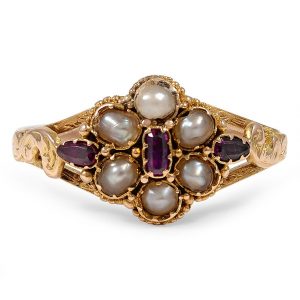Victorian betrothal rings or engagement rings are those which were designed and used during the Victorian era, from 1837 to 1901. Queen Victoria herself had a great influence on the styles of jewelry during her time.

She was fond of jewelry and had an everlasting affection for her husband, Prince Albert. It was her love for a diamond that led to a revolution in diamond rings making them the favorite of all and within some time, turned into a tradition.
Jewelry During the Victorian Era
When it comes to jewelry, the Victorian era has been classified into three parts – Early Victorian era, the mid-Victorian era, and late Victorian era. Many changes in the preference of metals and diamonds as well as gemstones were seen during the Victorian era.
Before 1854, lower karat gold alloys were used to make jewelry. Precious rings were created with 22k or 18k gold which had 75% of pure gold alloyed with copper, silver, nickel or sometimes a mixture of all these metals.

Rings were also made of silver before 1854. But after 1854, gold standards changed and even rings made of 15k, 12k and 9k gold were found in the market. The second biggest and most important change that took place was once the diamond mines in South Africa were opened in 1870.
Before this time, diamonds were rare and even if they were seen, clusters of small diamonds were found in the diamond rings. However, after 1870 and after the opening of South African large diamonds were made available and were pompously used in the making of wedding rings and engagement rings.
Early Victorian Betrothal Rings
Early Victorian engagement rings and wedding rings could be easily distinguished by their huge size and bright colors. Gemstones were used and bold designs were created in which the snake design was quite famous.

Celtic types designs were also pretty common these days. During this time, flashy and over-the-top designs were more common. These were from the heydays and early married days of Queen Victoria and Prince Albert.
Victorian Engagement Rings History
The popularity of the snake patterned ring was because Albert had presented her a snake and emerald ring as a betrothal ring. During that time, people blindly followed and considered whatever queen Victoria wore as the fashion. In fact, right from that time, the Victorian engagement rings enjoyed years of popularity.
Gemstones popularly used during this time were amethyst, ruby, smoky quartz, chalcedony, moss agate, bloodstone, garnet, and topaz. It was a trend during those days and the rings were usually made of the bride’s birthstone.

Diamond rings were mainly small clusters of diamond or a small diamond surrounded by circular or square shaped gemstones. The brilliant cut was the most popular diamond cut at that time along with the old rose cut.
The base metal was of 22k or 18k gold. A gold imitation made of copper and zinc which was called Pinchbeck was also used in making jewelry. Motifs were generally taken from nature and were butterflies, garlands, daisies, clover, doves, gothic symbols, snake and letters.
Mid-Victorian Era Betrothal Rings
During the middle years of the Victorian era, the engagement ring style took a different tone. Prince Albert died in 1861 and Queen Victoria took a long time to come out of the grief. During this time, memorial rings which were also known as mourning rings became highly popular. These were famous during the Georgian era too, a few years back.
During this time, the base metal was usually silver and gold with different karat values ranging from 18k to 9k. Rings made of gold alloyed with copper which was called rose gold rings were also very popular. Prevalent gemstones and designs during this time were emeralds, pearls, diamonds, opals, crystals, jet, black glass, and the ruby.
The designs became more sophisticated and less showy. Popular jewelry design motifs were hearts, acorns, stars, bees, birds, insects, shells, some flowers as well as geometrical shapes. A gradual increase in the use of gold and diamond jewelry had started to be seen by this time.
Late Victorian Wedding Rings
The late Victorian era saw wedding rings designed in the shape of a boat, more use of pearls and light airy styles was seen. These rings worked as inspiration for the Edwardian era which was soon to arrive.
The diamond rush brought big changes in the engagement rings of the Victorian era. There was a shift from handcrafted rings to machine-made rings during this time. gradually the age-old technique of metal work was lost in history.

The late Victorian era saw solitaire diamond engagement ring made its debut and this became highly popular in the mid-1840s. People started using platinum for gemstones and diamond was also started to be set with platinum replacing gold and silver to a large extent.
During this time, the popular motifs were stars, feathers, bows and ribbons, lace-type filigree, double hearts, doves, oak leaves, crowns, grape clusters, and Egyptian designs. Popular gemstones were rubies, sapphires, aquamarine, peridot, chrysoberyl, turquoise opals, amethyst, and emeralds.

Betrothal rings were made of metals including 18k, 15k, 12k, and 9k yellow gold along with silver, rose gold and platinum. These were the preferred metals for diamond and different gemstones set in luxurious places.
Antique Victorian Rings
Even today, if you go searching for Victorian engagement rings, you will find the designs and styles and even the original rings of that time available. Antique rings bought from genuine sources provide a complete report on the stones along with carat weight and clarity grades.
More Info O, Victorian Betrothal Ringsn- Lovers’ Knot Ring, Mourning Rings, Antique Edwardian Era Rings, Garnet Ring